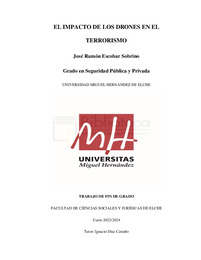Por favor, use este identificador para citar o enlazar este ítem:
https://hdl.handle.net/11000/33880El impacto de los drones en el terrorismo
| Título : El impacto de los drones en el terrorismo |
| Autor : Escobar Sobrino, José Ramón |
| Tutor: Díaz Castaño, Ignacio |
| Editor : Universidad Miguel Hernández de Elche |
| Departamento: Departamentos de la UMH::Ciencia Jurídica |
| Fecha de publicación: 2024-09 |
| URI : https://hdl.handle.net/11000/33880 |
| Resumen : En la última década, el uso de drones ha experimentado un rápido crecimiento en varios ámbitos gracias a sus múltiples propósitos, desde aplicaciones civiles hasta militares. La casi omnipresencia de estos se debe a su capacidad para responder a las necesidades de las personas, brindando a los usuarios una vista aérea que puede activarse y usarse casi en cualquier lugar y en cualquier momento. Sin embargo, también existe el uso de los drones para fines criminales e incluso terroristas. Este trabajo se centra en el análisis del papel de los drones en las estrategias terroristas contemporáneas. El objetivo principal es examinar el impacto de los drones en los ataques terroristas, con el fin de comprender el papel que han tenido realmente en este ámbito y poder explicar mejor la amenaza emergente. Exploramos cómo estos vehículos aéreos no tripulados han alterado la dinámica del terrorismo, proporcionando a los actores no estatales nuevas capacidades operativas y tácticas, adoptando vehículos aéreos no tripulados armados en sus repertorios. En primer lugar, se realiza una revisión de las teorías actuales sobre el uso de los drones en los conflictos armados, del origen de los drones y su evolución. Analizamos la situación actual de los drones comerciales y su transformación en armas de guerra, así como su accesibilidad y casos de uso por parte de grupos terroristas y actores estatales en conflicto. A continuación, se lleva a cabo un análisis descriptivo de los diferentes usos que los grupos terroristas dan a esta tecnología y casos de ataques. Además, se realiza un análisis de las series temporales de ataques terroristas con drones. Se examinan los datos disponibles y buscamos posibles patrones y tendencias a lo largo del tiempo con el objetivo de establecer una relación entre los conflictos armados y el uso de drones terroristas. Además, se analiza las repercusiones en la seguridad de los ataques terroristas con drones. Se examinan los riesgos, la vulnerabilidad de infraestructuras críticas y las posibles estrategias de prevención y respuesta. Finalmente, se muestran casos de uso a gran escala por actores estatales demostrando que estos también hacen uso de esta tecnología y una pequeña recapitulación de los hallazgos encontrados. Así, este trabajo contribuye a la comprensión de un fenómeno emergente que plantea desafíos significativos para la seguridad global, proporcionando información y hallazgos que ayuden a mejorar la comprensión de esta amenaza, ya que la probabilidad de estos ataques es alta y su impacto puede tener efectos devastadores. In the last decade, the use of drones has experienced rapid growth in various areas thanks to their multiple purposes, from civil to military applications. Their near-ubiquity is due to their ability to respond to people's needs, providing users with an aerial view that can be activated and used almost anywhere and at any time. However, there is also the use of drones for criminal and even terrorist purposes. This work focuses on the analysis of the role of drones in contemporary terrorist strategies. The main objective is to examine the impact of drones on terrorist attacks, in order to understand the role they have actually played in this area and to better explain the emerging threat. We explore how these UAVs have altered the dynamics of terrorism, providing non-state actors with new operational and tactical capabilities, adopting armed UAVs into their repertoires. Firstly, a review of current theories on the use of drones in armed conflicts, the origin of drones and their evolution is carried out. We analyze the current situation of commercial drones and their transformation into weapons of war, as well as their accessibility and use cases by terrorist groups and state actors in conflict. Next, an analysis is carried out of the different uses that terrorist groups give to this technology and cases of attacks. In addition, an analysis of the time series of terrorist attacks with drones is carried out. We examine the available data and look for possible patterns and trends over time with the aim of establishing a relationship between armed conflicts and the use of terrorist drones. In addition, the security repercussions of terrorist drone attacks are analyzed. Risks, vulnerability of critical infrastructure, and possible prevention and response strategies are examined. Finally, large-scale use cases by state actors are shown, demonstrating that they are the ones that make the greatest use of this technology and a small recapitulation of the findings found. Thus, this work contributes to the understanding of an emerging phenomenon that poses significant challenges for global security, providing information and findings that help improve the understanding of this threat, since the probability of these attacks is high and their impact can have devastating effects. |
| Palabras clave/Materias: Terrorismo drones amenaza seguridad/ Terrorism drones |
| Área de conocimiento : CDU: Ciencias sociales: Derecho |
| Tipo de documento : info:eu-repo/semantics/bachelorThesis |
| Derechos de acceso: info:eu-repo/semantics/openAccess |
| Aparece en las colecciones: TFG - Grado de Seguridad Pública y Privada |
 La licencia se describe como: Atribución-NonComercial-NoDerivada 4.0 Internacional.
La licencia se describe como: Atribución-NonComercial-NoDerivada 4.0 Internacional.
.png)
